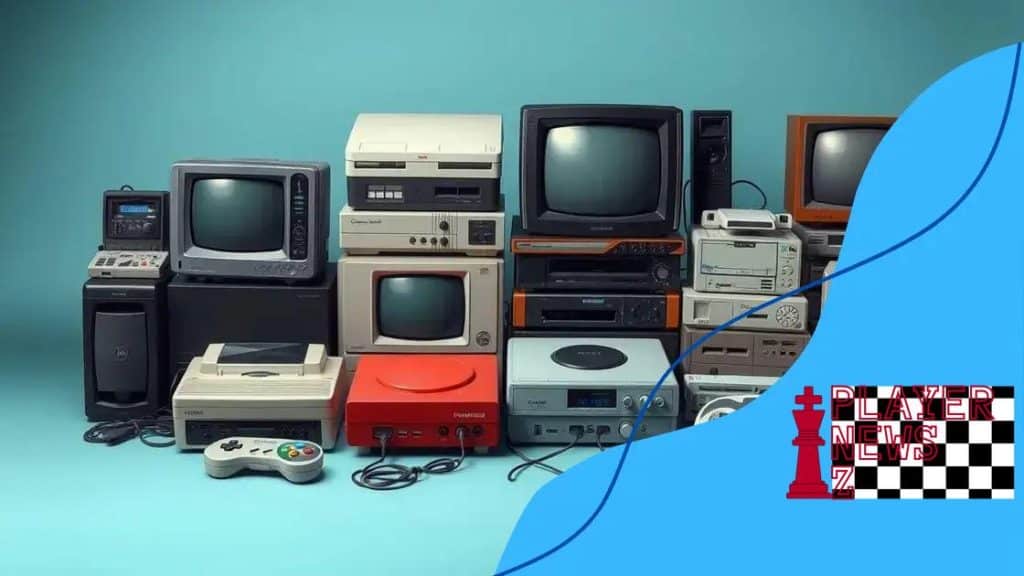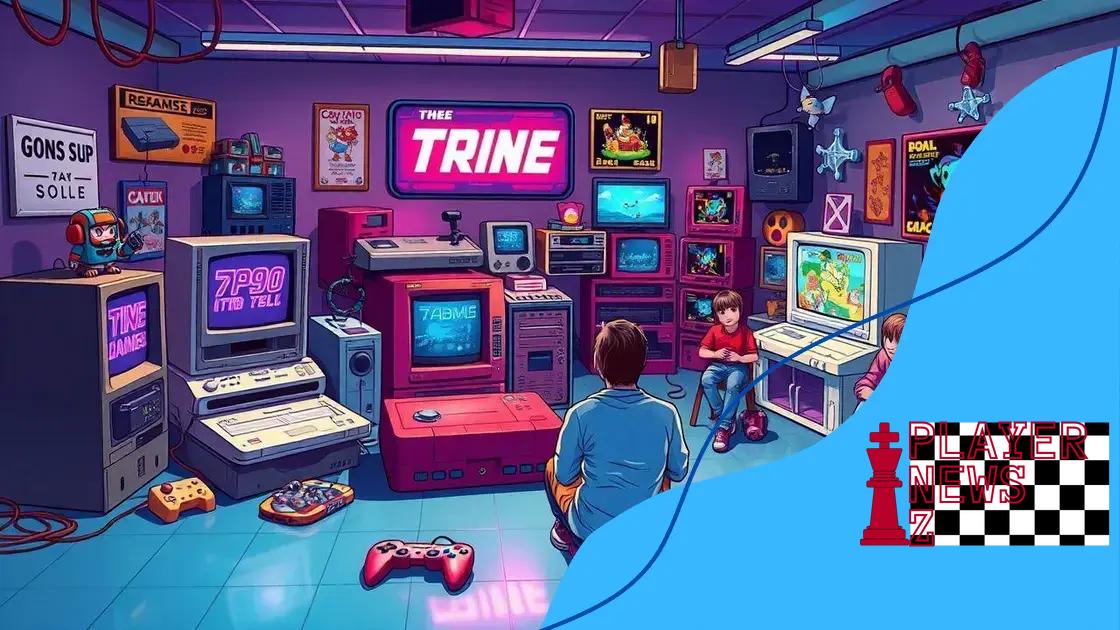Most popular retro games from the 70s, 80s, 90s and 2000s

Collecting retro games is a popular hobby that connects players to gaming history, blending nostalgia, community engagement, and investment potential, while also preserving the creative innovations of earlier gaming eras.
Most popular retro games 70s, 80s, 90s and 2000s have left a lasting mark on gamers of all ages. From pixelated adventures in the 70s to the immersive experiences of the 2000s, each era brought unique classics that still resonate today. Ready to take a nostalgic trip?
Iconic games from the 70s
The iconic games from the 70s marked the beginning of a gaming revolution. Pioneering developers introduced new ideas and creative concepts that shaped future gameplay. In this exhilarating chapter, games were not just a hobby but a cultural phenomenon.
Key Titles of the 70s
Several games stood out during this vibrant decade. They not only entertained but also changed how we perceive gaming. Let’s look at a few of these groundbreaking titles:
- Pong: One of the first video games, it captured hearts with its simple ping-pong action.
- Space Invaders: This game introduced the concept of high scores, captivating players globally.
- Atari 2600: A gaming console that brought home entertainment, setting the stage for future consoles.
The impact of these games was profound. They helped to establish the video gaming industry, inviting players into immersive worlds. The simplicity of Pong showcased the appeal of video games, while Space Invaders created a competitive atmosphere through scoring. With the release of the Atari 2600, gaming moved beyond arcades, making it accessible to families everywhere.
Innovation and Challenges
The 70s were also filled with innovation and challenges. Developers faced the task of creating engaging gameplay with limited technology. They experimented with graphics and sound, pushing the boundaries of what was possible. As players flocked to arcades, competition increased.
Many companies struggled to keep up with the demand. This era laid the groundwork for future advancements, reinforcing the significance of innovation in game design. As a result, the gaming community began to grow.
The evolution of gaming in the 80s
The evolution of gaming in the 80s brought significant changes to the industry. As technology advanced, console and arcade games began to feature vibrant graphics and more complex gameplay. This was a time of growth, exploration, and innovation that shaped gaming as we know it today.
Key Innovations
During this decade, several key innovations emerged that transformed the gaming landscape. Notable advancements included:
- Color Graphics: Games became visually appealing with the introduction of color graphics, enhancing user experience.
- Microprocessor Technology: Improved processing power allowed for more intricate game designs and better performance.
- Home Consoles: Systems like the NES revolutionized gaming, bringing arcade experiences into the living room.
These innovations sparked a wave of creativity across the gaming industry. Developers began to create more engaging stories and immersive worlds. As a result, players enjoyed a wider variety of gaming experiences than ever before, from adventure to puzzle-solving.
Popular Games of the 80s
The 80s also introduced several iconic games that became household names. Players loved titles like Pac-Man, which captivated audiences with its unique gameplay. Other notable games included Donkey Kong, where players navigated platforms to save a damsel in distress, and Super Mario Bros., which redefined platform gaming.
These games not only contributed to the gaming culture but also set high standards for future releases. Players eagerly anticipated new titles, creating a thriving gaming community.
The Rise of Competitive Gaming
With the popularity of these games, the concept of competitive gaming began to rise. Tournaments emerged, and players showcased their skills in various competitions. This competitive spirit fueled excitement and loyalty among fans, establishing a foundation for the esports movement that we see today.
The industry continued to flourish as gaming became a social activity. Friends would gather to play their favorite titles, sharing tips and strategies. This connectivity made gaming an important cultural phenomenon.
90s games that defined a generation

The 90s games that defined a generation were pivotal in transforming the gaming industry. This decade brought about revolutionary advancements in technology and creativity that captured the hearts of millions. Players were treated to more advanced graphics, richer storytelling, and immersive gameplay experiences.
Groundbreaking Titles
Several games from the 90s left a lasting impact on the gaming world. From platformers to role-playing games, these titles redefined fun and excitement:
- Super Mario 64: This game introduced a 3D world, allowing players to experience their favorite plumber’s adventures in a whole new way.
- The Legend of Zelda: Ocarina of Time: Offering a captivating story and expansive open world, this game is often regarded as one of the best ever made.
- Street Fighter II: This fighting game popularized competitive play, sparking interest in esports and tournaments.
These games not only entertained but also pioneered new genres, inspiring countless developers and gamers. The evolution of game design during the 90s created unforgettable experiences, paving the way for future innovations.
The Rise of 3D Graphics
One of the most significant breakthroughs in the 90s was the shift from 2D to 3D graphics. Developers embraced this technology, leading to a more immersive gaming experience. Games such as Doom and Quake exemplified this shift, allowing players to navigate complex environments and explore virtual worlds.
The appeal of 3D visuals drew in new audiences, expanding the gaming community. The excitement surrounding these titles fueled imagination and set new standards for realism in gaming.
Community and Cultural Impact
The gaming community flourished during the 90s, with players bonding over their favorite titles. Console wars, particularly between the Sega Genesis and Nintendo, ignited passionate discussions among fans. Online forums and gaming magazines helped cultivate this sense of belonging.
Furthermore, the 90s saw the emergence of iconic characters who became household names. Characters like Sonic the Hedgehog and Link resonated with players, creating a connection that remains strong today. These beloved characters contributed to gaming’s cultural significance.
2000s classics and their impact
The 2000s classics had a profound impact on how video games are designed and played. This decade marked a significant shift in gaming culture, with new genres emerging and established franchises evolving. As technology advanced, games became more complex and engaging, appealing to a broader audience.
Defining Games of the 2000s
Several titles from the 2000s stand out as classics that shaped the gaming landscape:
- Halo: Combat Evolved: Revolutionized first-person shooters on consoles, offering multiplayer modes and an epic storyline.
- World of Warcraft: Became a cultural phenomenon by popularizing MMORPGs and creating a vibrant online community.
- The Legend of Zelda: The Wind Waker: Introduced a unique cel-shading art style, making the game visually distinct and charming.
These classics not only pushed the boundaries of gameplay but also set new standards for storytelling and immersive experiences. They captivated millions of players and established dedicated fan bases.
The Rise of Online Gaming
During the 2000s, online gaming gained immense popularity. Players could connect with others across the globe, creating a sense of community. World of Warcraft played a significant role in this movement, allowing users to join forces and tackle challenges together.
This shift led to the rise of esports, where competitive gaming tournaments became mainstream. Players honed their skills and competed for prizes, transforming gaming into a spectator sport.
Impact on Game Design and Technology
The evolution of technology during the 2000s facilitated groundbreaking game design. Developers embraced advancements in hardware, leading to better graphics, realistic physics, and improved AI. As a result, games became more engaging and lifelike.
New genres emerged, such as open-world games, which offered players unparalleled freedom to explore vast environments. Titles like Grand Theft Auto: San Andreas allowed players to interact with the world in unique ways, providing hours of entertainment.
Collecting retro games today
Collecting retro games today has become a popular hobby for many gaming enthusiasts. As technology rapidly evolves, these classic games hold a special charm and nostalgia for both collectors and players. The thrill of finding rare cartridges or consoles can bring a sense of excitement that newer games often lack.
Why Collect Retro Games?
Many collectors are driven by a desire to relive their childhood memories or to introduce younger generations to gaming history. Retro games can provide a window into the past, showcasing the evolution of gameplay and technology. Collecting these games allows fans to appreciate the creativity and innovation that defined earlier gaming eras.
- Historical Significance: Each game tells a story and reflects the trends and culture of its time.
- Investment Potential: Some retro games can increase in value over time, making them a viable investment.
- Community Engagement: Collecting encourages interaction with fellow gamers who share similar passions.
These reasons add to the allure of collecting retro games, fostering a sense of belonging and passion among gamers.
How to Start Collecting Retro Games
If you’re interested in starting your collection, several steps can guide you. First, identify which systems and games resonate with you the most. Whether it’s the classic NES, Sega Genesis, or even arcade cabinets, focus on what excites you.
Next, explore local game shops, flea markets, and online marketplaces where you can find retro games. Building relationships with sellers can lead to great finds. Keep in mind that condition is important; games in their original packaging or with manuals are often more valuable.
Preservation and Care
Once you begin collecting, it’s essential to take good care of your games. Store cartridges properly to avoid damage, and consider investing in protective cases. Regularly cleaning your consoles and games ensures they remain in good working condition.
This attention to detail not only helps maintain the value of your collection but also enhances your enjoyment of playing these timeless classics.
Conclusion:
Collecting retro games is not just a fun hobby; it’s a way to connect with the past and enjoy the rich history of gaming. These classic games provide a unique experience that blends nostalgia and community. As the gaming landscape continues to evolve, preserving and appreciating retro games allows current and future generations to enjoy the creativity and innovation that shaped the industry. Whether you’re a seasoned collector or just starting, every game adds value to your collection and enhances your gaming journey.
FAQ – Frequently Asked Questions about Collecting Retro Games
What is the best way to start collecting retro games?
Start by deciding which gaming systems you enjoy most and then explore local shops, online marketplaces, and gaming conventions for finding titles.
How do I determine the value of a retro game?
The value can depend on factors like rarity, condition, and demand among collectors. Websites and forums dedicated to retro gaming often provide pricing guides.
Is it worth collecting games in their original packaging?
Yes, games in original packaging, especially with manuals, tend to have higher value and appeal to collectors due to their completeness.
How can I preserve my retro games?
Store cartridges in cool, dry places, keep them away from direct sunlight, and consider using protective cases to prevent damage.





